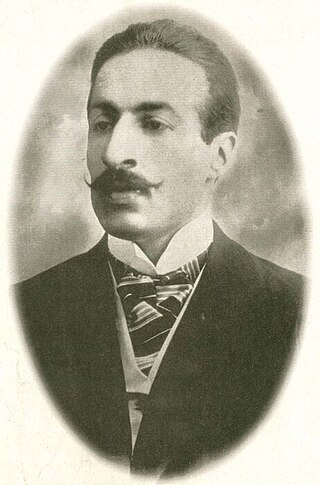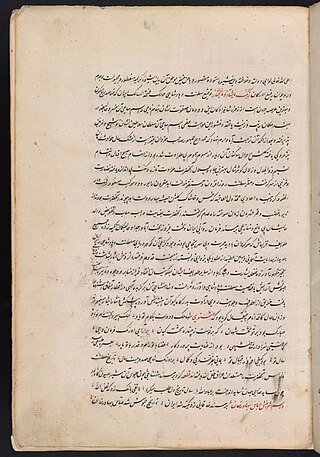
Shahre Ray, Shahr-e Ray, Shahre Rey, or Shahr-e Rey or simply Ray or Rey (ری), is the capital of Rey County in Tehran Province, Iran. Formerly a distinct city, it has now been absorbed into the metropolitan area of Greater Tehran as the 20th district of municipal Tehran, the capital city of the country.
Muhammad Falaki, commonly known as Falaki Shirvani was a poet who served at the court of the Shirvanshah Manuchihr III. A student of the poet Khaqani, Falaki is known to have authored a Persian divan, of which 1,512 verses have survived. He played a leading role in the early development of the habsiyat, a genre in Persian literature.

Khanlar Mirza Ehtesham-ed-Dowleh was a Qajar prince who held the governorship of several Iranian provinces during the reigns of Mohammad Shah Qajar and Naser al-Din Shah Qajar. He was the seventeenth son of Abbas Mirza.

Mirza Ebrahim Khan Akkas Bashi was an Iranian photographer and cinematographer. He became the first cinematographer of the country on 15 August 1900, when he recorded Mozaffar ad-Din Shah Qajar strolling on the beach of the town of Ostend in Belgium.
Abu al-Hasan Bahmanyar ibn al-Marzban, better simply known as Bahmanyar was an Iranian scholar, who is mainly known as one of the most prominent pupils of Avicenna.

The Marzbān-nāma is an early 13th-century Persian prose work. It consists of "various didactic stories and fables used as illustrations of morality and right conduct", and belongs to the "mirror for princes" literary genre. It was written in 1210–1225 by Sa'ad al-Din Varavini, under the patronage of Abu'l-Qasem Harun, the vizier of the Eldiguzid ruler (atabeg) Muzaffar al-Din Uzbek.

Iskandar Beg Munshi was an Iranian court scribe and chronicler, who is principally known for his historical book of Tarikh-e Alam-ara-ye Abbasi, which focuses on early Safavid history, especially the reign of Shah Abbas I.

Farrokh Khan, also known as Amin ol-Dowleh (امینالدوله), was a high-ranking Iranian official from the Ghaffari family. Between 1855–1857, he served as the Iranian ambassador to the French court in Paris, where he assisted in signing the Treaty of Paris, thus ending the losing Anglo-Persian War and withdrawing the Iranian army from Herat.

Abdallah Khan was an Iranian court painter and architect of the Qajar era who was active between 1810 and 1850. His greatest work is a grand mural in the Negarestan Palace, Tehran, and he is also known to have painted murals at the Soleymaniyeh Palace in Karaj, life-size portraits and other works.
Abu'l-Hasan Ali ibn Fadl ibn Ahmad Isfarayini, commonly known as Abu'l-Hasan Isfarayini, was a Persian vizier of the Ghaznavid sultan Mahmud of Ghazni from 998 to 1010.
Bahram Mirza Safavi was a Safavid prince, governor and military commander in 16th-century Iran. He was the youngest son of Shah Ismail I, the founder of the Safavid dynasty.

The Anjoman-e Okhovat was a Freemason-like mystical society rooted in Sufism. Founded in Qajar Iran, in 1899, it was originally a continuation of the Safi'alishahi branch of Ni'matullāhī, an Iranian Shia Sufi order.
Abu'l-Hasan Ali Rayhani was an Iranian author, bureaucrat and poet, who served as a high ranking civil secretary (katib) under the Abbasid caliph al-Mamun.
Abu'l-Hasan Mostawfi Ghaffari was an 18th-century Iranian painter and historian from the Ghaffari family of Kashan. Besides several European-style paintings, he is also known to be the author of the Golshan-e Morad, a book covering the history of the Zand dynasty.
The Golshan-e Morad is a historical text of the Zand dynasty by Abu'l-Hasan Mostawfi Ghaffari.

Morad Mirza Hesam o-Saltaneh was a Qajar prince, governor and military officer in 19th-century Iran. A son of the crown prince Abbas Mirza, Morad Mirza held various governorships throughout his career, including the Khorasan province five times.

Hamzeh Mirza Heshmat od-Dowleh was a Qajar prince, governor and military officer in 19th-century Iran. The son of the crown prince Abbas Mirza, Hamzeh Mirza held various governorships and led several military campaigns, notably against the Revolt of Hasan Khan Salar. He remained active in the country's military and administrative affairs until his death.

Mirza Hashem Khan Ghaffari was an Iranian official from the Ghaffari family. Until 1861/62, he managed the private finances of Naser al-Din Shah. He was afterwards appointed to three offices; amin-e khalwat, the custodian of the personal estate of the shah, which was a newly created title and office which would remain exclusive to the Ghaffari family; the chief of the court personnel; the commander of the royal musketeers; and the dean of the shah's household. In 1871, a seat in the government's Consultative Assembly was granted to Mirza Hashem Khan. Later that year, following the death of Mirza Hashem Khan's brother Farrokh Khan in May, Nasir al-Din Shah appointed him vazir-e hozur and bestowed upon him his brother's title of Amin od-Dowleh.

Mohammad-Ebrahim Khan Ghaffari was an Iranian diplomat and minister during the late Qajar era. A member of the Ghaffari family, he was the son of the high-ranking official Farrokh Khan.












